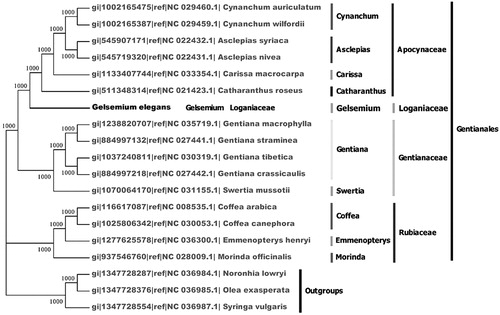Abstract
In this study, we show the complete chloroplast genome in G. elegans by high-throughput sequencing. The chloroplast genome in G. elegans is 155,018 bp in size, comprising a pair of inverted repeats (IRa and IRb) of 25,728 bp each and an LSC region of 85,619 bp and an SSC region of 17,943 bp. The genome includes 117 single-copy genes (29 tRNA, 8 rRNA genes and 80 protein-coding). Phylogenetic analysis using total chloroplast genome DNA sequence of 15 species belonging to Gentianales showed that Apocynaceae and Loganiaceae form a single cluster with closer relationship to Gentianaceae than with Rubiaceae.
Gelsemium elegans Benth, belongs to the genus Gelsemium (Loganiaceae). As a small genus, Gelsemium includes G. elegans Benth, G. semperviren Ait, and G. rankinii Small. Gelsemium elegans is distributed in Southeast Asia, especially in China, and the other two species are predominant in North America (Xu et al. Citation2006) . It has been well studied that Gelsemium extract and its active alkaloids have a variety of biological functions, such as anti-tumor, anti-cancer, anti-inflammatory, anti-cytotoxicity, anti-epidermal cell proliferation, anti-arrhythmic, analgesic and immunomodulating activities (Kitajima et al. Citation2003; Kogure et al. Citation2006; Xu et al. Citation2012; Qu et al. Citation2013; Wu et al. Citation2015; Zhang and Wang Citation2015). Our study can be used in the study of population genetics and evolutionary studies, and contribute to future related research.
Fresh leaves in G. elegans were collected from cultivated fields in Lian Jiangkou town, Qingyuan City, Guangdong Province, China(113.369606, 23.996038)and then stored in –80 °C. High-quality DNA (A260/280 = 1.8–2.0; A260/230 > 1.7; concentration >0.1 μg/μl) isolated from leaf tissues was prepared for Illumina MiSeq paired-end sequencing, using Miseq2*300 model. The low-quality fragments and excision of reads containing N partial sequence (length <35 bp) were removed by sliding window method. The original scaffold is obtained by SPAdes, then the scaffold is patched by Gapcloser and GapFiller, and PrInSeS-G is used for sequence correction. The final assembled chloroplast sequence was annotated with DOGMA (Wyman et al. Citation2004) and BLAST. All tRNAs genes were predicted using tRNAscan-SE search sever (Schattner et al. Citation2005) and identified by comparison with relative species in Gentianales.
The cp genome in G. elegans (accession number: MH327990) is a circular quadripartite molecule with a length of 155,018 bp, containing an LSC region of 85,619 bp, an SSC region of 17,943 bp and a pair of inverted repeats (IRa and IRb) of 25,728 bp each. Coding regions comprise 47.6%, 7.5% correspond to rRNAs and tRNAs, and non-coding regions comprises 44.9% of the genome, including introns, intergenic spacers and pseudogenes. There are 125 genes predicted, including 117 single-copy genes (80 protein-coding, 29 tRNA, and eight rRNA genes). Our results show that the size of chloroplast genome in G. elegans and the other three chloroplast genomes in Gentianales (Zhang and Wang Citation2015; Jang et al. Citation2016; Xiang et al. Citation2016) is similar. The main contribution to the difference in length is found in the LSC regions, ranging in lengths from 83,567 to 99,973 bp.
For the phylogenetic analysis, a total DNA sequence of cp genome in 15 species in Gentianales were used. Nucleotide sequences were aligned by Mafft version 7 (https://mafft.cbrc.jp/alignment/software/) and a NJ tree was generated using clustalX2 with bootstrap value of 1000. The phylogeny analysis includes the sister relationship of the families in Apocynaceae, Gentianaceae, and Rubiaceae. By analyzing the order clade in Gentianales the results showed that Apocynaceae and Loganiaceae form a single cluster of Gentianales, and this clade has a shorter genetic distance with Gentianaceae than to the Rubiaceae ().
Acknowledgments
We wish to appreciate to our anonymous reviewers for providing valuable comments on the manuscript.
This study was carried out with financial supported by the earmarked fund for China Agriculture Research System [CARS-45-49], Science and Technology Planning Project of Guangdong Province [2017A020225035], Fund Fostering Talents for Young Scholars of South China Agricultural University [201707N025]; Scientific Research Staring Foundation for Young Scholars of College of Marine Sciences and Talent introduction special funds of South China Agricultural University.
Disclosure statement
The authors report no conflict of interest. The authors alone are responsible for the content and writing of the paper.
References
- Jang W, Kim KY, Kim K. 2016. The complete chloroplast genome sequence of Cynanchum auriculatum Royle ex Wight (Apocynaceae). Dna Sequence 27:4549–4550.
- Kitajima M, Kogure N, Yamaguchi K, Takayama H, Aimi N. 2003. Structure reinvestigation of gelsemoxonine, a constituent of Gelsemium elegans, reveals a novel, azetidine-containing indole alkaloid. Org Lett. 5:2075–2078.
- Kogure N, Ishii N, Kitajima M, Wongseripipatana S, Takayama H. 2006. Four novel gelsenicine-related oxindole alkaloids from the leaves of Gelsemium elegans Benth. Org Lett. 8:3085–3088.
- Qu J, Fang L, Ren X, Liu Y, Yu S, Li L, Bao X, Zhang D, Li Y, Ma S. 2013. Bisindole alkaloids with neural anti-inflammatory activity from Gelsemium elegans. J Nat Prod. 76:2203–2209.
- Schattner P, Brooks AN, Lowe TM. 2005. The tRNAscan-SE, snoscan and snoGPS web servers for the detection of tRNAs and snoRNAs. Nucleic Acids Res. 33:W686–W689.
- Wu H, He X, Jin X, Pan H, Shi Z, Xu D, Yao X, Zhu Y. 2015. New nor-ursane type triterpenoids from Gelsemium elegans. Fitoterapia. 106:175–183.
- Wyman SK, Jansen RK, Boore JL. 2004. Automatic annotation of organellar genomes with DOGMA. Bioinformatics. 20:3252–3255.
- Xiang B, Li X, Qian J, Wang L, Ma L, Tian X, Wang Y. 2016. The Complete Chloroplast Genome Sequence of the Medicinal Plant Swertia mussotii Using the PacBio RS II Platform. Molecules 21:1029.
- Xu Y, Liao S, Na Z, Hu H, Li Y, Luo H. 2012. Gelsemium alkaloids, immunosuppressive agents from Gelsemium elegans. Fitoterapia. 83:1120–1124.
- Xu Y, Yang S, Liao S, Zhang H, Lin L, Ding J, Yue J. 2006. Alkaloids from Gelsemium elegans. J Nat Prod. 69:1347–1350.
- Zhang J, Wang Y. 2015. Gelsemium analgesia and the spinal glycine receptor/allopregnanolone pathway. Fitoterapia. 100:35–43.

